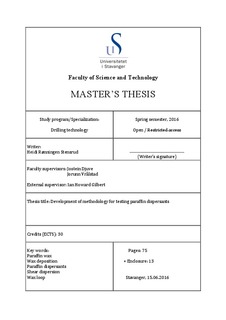| dc.contributor.advisor | Djuve, Jostein | |
| dc.contributor.advisor | Vrålstad, Jorunn | |
| dc.contributor.advisor | Gilbert, Ian Howard | |
| dc.contributor.author | Rønningen Stensrud, Heidi | |
| dc.date.accessioned | 2016-09-21T08:09:15Z | |
| dc.date.available | 2016-09-21T08:09:15Z | |
| dc.date.issued | 2016-06-15 | |
| dc.identifier.uri | http://hdl.handle.net/11250/2409069 | |
| dc.description | Master thesis in Petroleum engineering | nb_NO |
| dc.description.abstract | This thesis presents the development of a methodology for testing paraffin dispersants.
Wax deposition is one of the main problems related to offshore production and transportation of crude oil. In the petroleum industry today paraffin inhibitors are the most commonly used chemicals to prevent wax deposition. In countries where environmental regulations are stipulated on biodegradation, the use of these non-biodegradable polymers restricts the use of such chemistry. Service companies are then only allowed to use biodegradable chemicals, which limits the chemicals to paraffin dispersants for paraffin control.
There was no standard technique defined to properly performance test paraffin dispersants. Based on this, a methodology for testing paraffin dispersants was developed.
The aim of this thesis was to develop a standard methodology for testing paraffin dispersants where the wax deposition was driven by shear dispersion rather than a thermal gradient, and to evaluate the performance of different types of paraffin dispersants in order to identify the best performers. In addition, different types of wax prevention chemicals were added to a crude oil sample, and the wax crystal structure and the effect of the chemicals was analysed.
Two different types of crudes were tested, and a number of tests were performed using a wax loop. When testing crude A having a wax content of 20.4%, one was able to obtain wax deposition driven by shear dispersion rather than a thermal gradient, and one could clearly differentiate between a good and bad performer when adding different types of paraffin dispersants to the crude oil sample. When repeating the methodology on crude D having a higher wax content and WAT, it was possible to obtain wax deposition driven by shear dispersion rather than a thermal gradient. Despite of this it was not possible to perform any further testing on crude D.
When looking at the structure of paraffin wax crystals at the microscope, the addition of different types of wax prevention chemicals did not result in a significant change in wax crystal structure. However, the addition of different types of wax prevention chemicals did influence the amount and size of wax crystals and the WAT of the crude. | nb_NO |
| dc.language.iso | eng | nb_NO |
| dc.publisher | University of Stavanger, Norway | nb_NO |
| dc.relation.ispartofseries | Masteroppgave/UIS-TN-IPT/2016; | |
| dc.rights | Navngivelse-Ikkekommersiell-IngenBearbeidelse 3.0 Norge | * |
| dc.rights.uri | http://creativecommons.org/licenses/by-nc-nd/3.0/no/ | * |
| dc.subject | paraffin wax | nb_NO |
| dc.subject | wax loop | nb_NO |
| dc.subject | thermal gradient | nb_NO |
| dc.subject | shear dispersion | nb_NO |
| dc.subject | wax deposition | nb_NO |
| dc.subject | wax crystal structure | nb_NO |
| dc.subject | petroleum engineering | nb_NO |
| dc.subject | petroleumsteknologi | nb_NO |
| dc.subject | drilling | nb_NO |
| dc.subject | boreteknologi | nb_NO |
| dc.title | Development of methodology for testing paraffin dispersants | nb_NO |
| dc.type | Master thesis | nb_NO |
| dc.subject.nsi | VDP::Technology: 500::Rock and petroleum disciplines: 510::Petroleum engineering: 512 | nb_NO |

